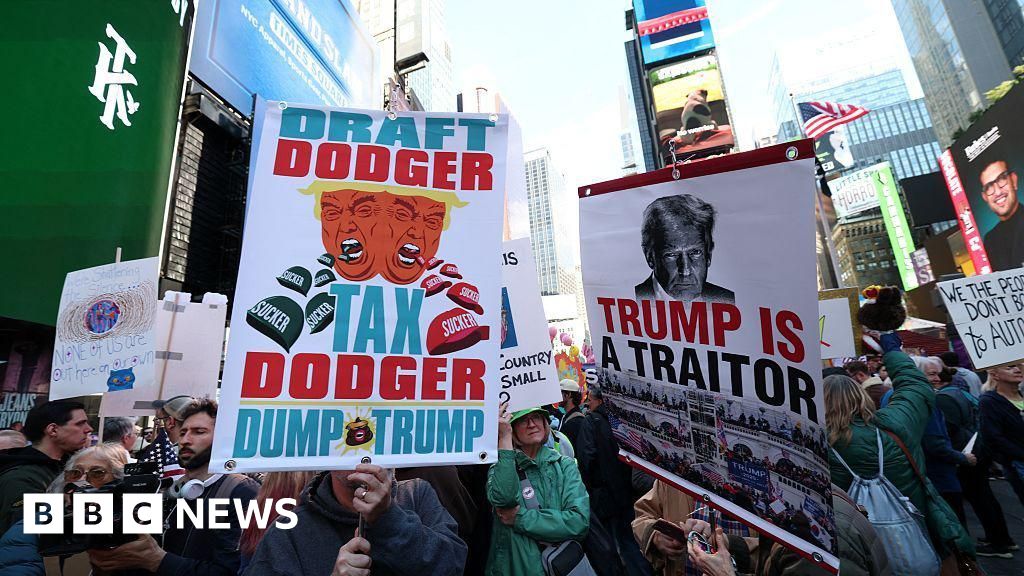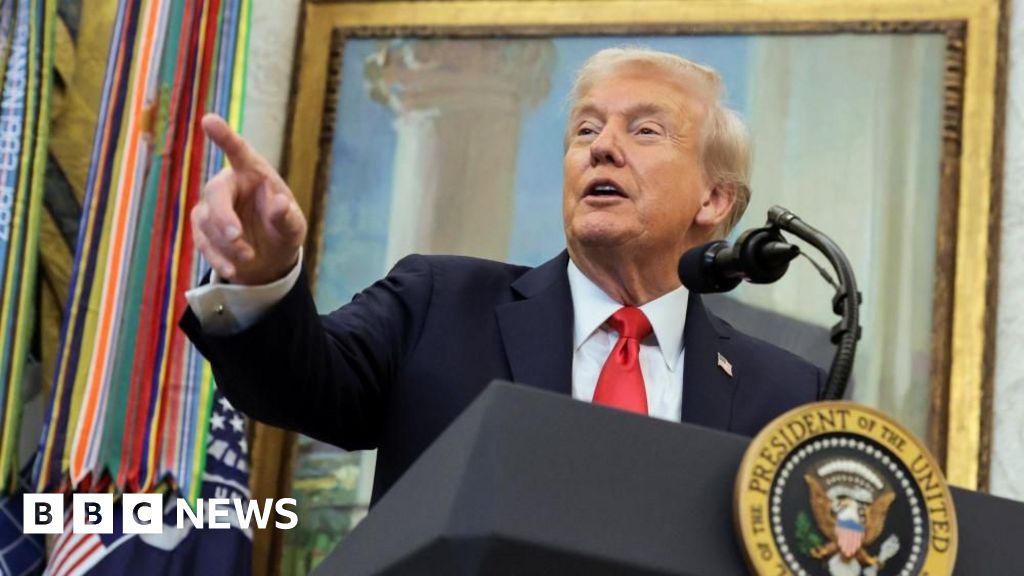Grace Eliza GoodwinNew York City and
Caitlin WilsonWashington, DC
Huge crowds have gathered to protest against President Donald Trump’s policies in cities across the US – among them New York, Washington DC, Chicago, Miami and Los Angeles.
The rally in New York City’s iconic Times Square drew thousands of people not long after it began on Saturday morning.
The streets and subway entrances were densely packed with people holding up signs with slogans like, “Democracy not Monarchy” and “The Constitution is not optional.”
Ahead of the demonstrations, Trump allies accused the protesters of being linked with the far-left Antifa movement, and condemned what they called “the hate America rally”.
Organisers and protesters out on Saturday said the events were peaceful.
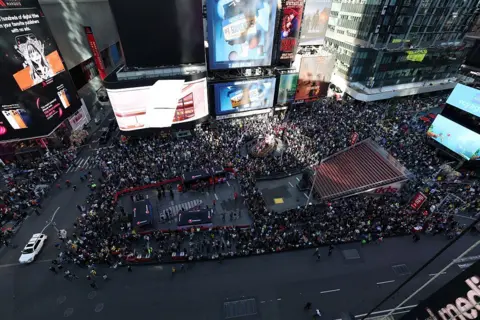 Getty Images
Getty ImagesNon-violence is a core principle of No Kings events, the group states on its website, which urges all participants to de-escalate potential altercations.
In New York, sections of the crowd regularly erupted into chants of “This is what democracy looks like” as a near-constant drumbeat boomed in the background alongside cowbells and noisemakers.
Helicopters and drones could be seen flying overhead, and police stood on the sidelines.
One organiser with a loudspeaker announced that 100,000 had shown up, though it’s not clear if he meant in the Times Square vicinity or across the city’s five boroughs where smaller rallies and events were also being held.
A police officer standing by estimated that over 20,000 were marching down 7th Avenue.
Beth Zasloff, a freelance writer and editor, said she had joined the New York protest because she feels outraged and distressed at what she called a “move toward fascism and an authoritarian government” happening in the Trump administration.
“I care a lot about New York City,” Zasloff said. “It gives me hope to be out here with many, many other people.”
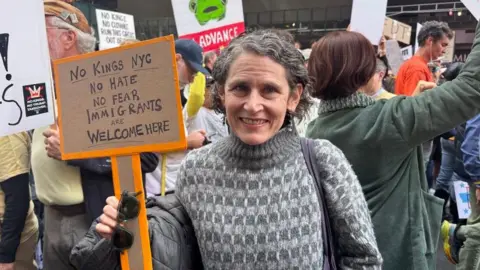 Grace Eliza Goodwin/BBC
Grace Eliza Goodwin/BBCSince returning to the White House, Trump has embraced an expansive view of presidential power, using executive orders to block funding approved by Congress and dismantle parts of the federal government, to introduce sweeping tariffs on other countries, and to deploy national guard troops to cities despite objections by state governors.
The president says his actions are necessary to rebuild a country in crisis and he has dismissed claims he’s a dictator or fascist as hysterical. But critics warn some of the moves by the administration are unconstitutional and a threat to American democracy.
Massimo Mascoli, a 68-year-old retired electronic engineer and resident of New Jersey who grew up in Italy, said he was protesting because he can’t watch the US descend into fascism as his home country did in the last century.
“I am the nephew of an Italian hero that deserted the Mussolini army and joined the resistance,” Mascoli said. “He was tortured and killed by the fascists, and after 80 years, I didn’t expect to find fascism again in the United States.”
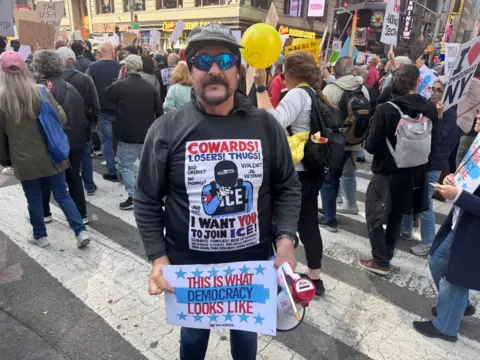 Grace Eliza Goodwin/BBC
Grace Eliza Goodwin/BBCMascoli is particularly concerned about the Trump administration’s immigration crackdown, implementation of widespread tariffs, deployment of National Guard troops into US cities, and cuts to healthcare for millions of Americans.
“We cannot count on the Supreme Court, we cannot count on the government,” Mascoli said. “We cannot count on the Congress. We have all the legislative, the executive and judiciary that are all against the American people right now. So we are fighting.”
Protests are expected to continue across the country throughout the day. In Washington DC, Vermont Senator Bernie Sanders delivered a keynote speech.
“We’re not here because we hate America, we’re here because we love America,” he said to a crowd of thousands.
At the DC march, the BBC saw one man wearing a hat emblazoned with Trump’s “Make American Great Again” slogan, who said he was in town to visit and decided to check out the protest. He declined to give his name, but said while he didn’t really “get it”, people had been civil. Shortly after, a woman shouted a derogatory comment at him.
Throughout Europe, protesters took to the streets in Berlin, Madrid and Rome earlier on Saturday to show solidarity with their American counterparts. A couple of hundred protesters also gathered outside the US embassy in London.
In Toronto, demonstrators near the US consulate general waved signs including “Hands off Canada”.
US protest organisers said the gatherings would challenge Trump’s “authoritarianism”.
In an interview with Fox News, set to air on Sunday but teased on Saturday, Trump appeared to address the upcoming rallies.
“A king! This is not an act,” Trump said in a preview clip of the interview. “You know – they’re referring to me as a king. I’m not a king.”
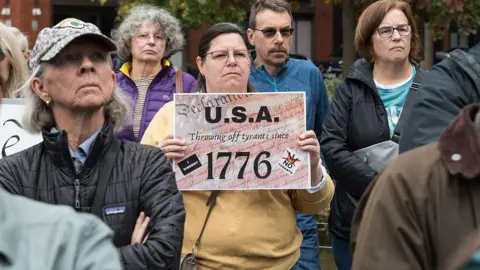 Getty Images
Getty Images“We’ll have to get the National Guard out,” Kansas Senator Roger Marshall said ahead of the rallies, according to CNN.
“Hopefully it’ll be peaceful. I doubt it.”
Republican governors in several US states have placed National Guard troops on standby, but it is unclear how visible the military presence there will be.
Texas Governor Greg Abbott on Thursday activated the state’s National Guard ahead of a protest scheduled in Austin, the state’s capital.
He said the troops would be needed due to the “planned antifa-linked demonstration”.
Democrats denounced the move, including the state’s top Democrat Gene Wu, who argued: “Sending armed soldiers to suppress peaceful protests is what kings and dictators do – and Greg Abbott just proved he’s one of them.”
Virginia’s Republican Governor Glenn Youngkin also ordered the state National Guard to be activated.
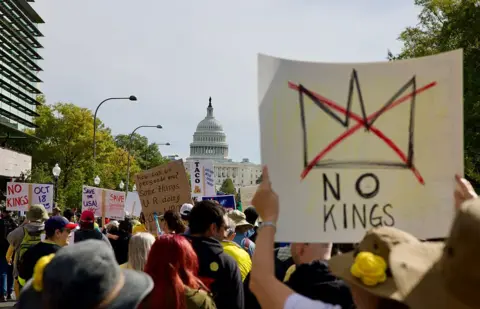 Getty Images
Getty ImagesIn Washington, DC, where the National Guard guard has been deployed since August at Trump’s request, no troops were visible at the protest, although local police were.
One protester at the rally in the capital held up a sign that read “I am antifa”.
Chuck Epes, 76, said it was a “loaded” term, and just meant he supported “peace, daycare, liveable wage, healthcare”, as well as immigrants and people of colour.
“He’s gaslighting everybody – or trying to, and it ain’t working,” he said.
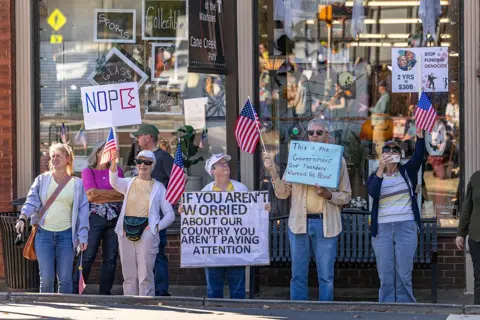 Getty Images
Getty ImagesAmericans are deeply divided on Donald Trump. A recent Reuters/Ipsos poll found that only 40% approved of his performance as president, while 58% disapproved. This puts him about on par with his average approval rating during his first term, but lower than his 47% approval rating when he took office for the second time in January.
It is common for presidents to become more unpopular as their term wears on. Joe Biden had a 55% approval rating, according to Reuters/Ipsos, in January 2021. By October of that year, his approval had declined to 46%.
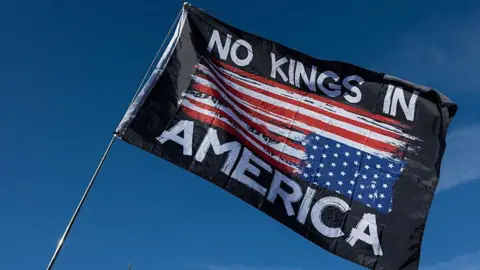 Getty Images
Getty Images
